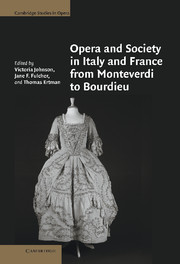17 results
List of musical examples
-
- Book:
- Opera and Society in Italy and France from Monteverdi to Bourdieu
- Published online:
- 22 September 2009
- Print publication:
- 03 May 2007, pp xiii-xiv
-
- Chapter
- Export citation
List of tables
-
- Book:
- Opera and Society in Italy and France from Monteverdi to Bourdieu
- Published online:
- 22 September 2009
- Print publication:
- 03 May 2007, pp xii-xii
-
- Chapter
- Export citation
List of illustrations
-
- Book:
- Opera and Society in Italy and France from Monteverdi to Bourdieu
- Published online:
- 22 September 2009
- Print publication:
- 03 May 2007, pp xi-xi
-
- Chapter
- Export citation
Index
-
- Book:
- Opera and Society in Italy and France from Monteverdi to Bourdieu
- Published online:
- 22 September 2009
- Print publication:
- 03 May 2007, pp 395-406
-
- Chapter
- Export citation
Acknowledgments
-
-
- Book:
- Opera and Society in Italy and France from Monteverdi to Bourdieu
- Published online:
- 22 September 2009
- Print publication:
- 03 May 2007, pp xxxii-xxxii
-
- Chapter
- Export citation
12 - Symbolic domination and contestation in French music: Shifting the paradigm from Adorno to Bourdieu
-
-
- Book:
- Opera and Society in Italy and France from Monteverdi to Bourdieu
- Published online:
- 22 September 2009
- Print publication:
- 03 May 2007, pp 312-329
-
- Chapter
- Export citation
Frontmatter
-
- Book:
- Opera and Society in Italy and France from Monteverdi to Bourdieu
- Published online:
- 22 September 2009
- Print publication:
- 03 May 2007, pp i-viii
-
- Chapter
- Export citation
5 - The effect of a bomb in the hall: The French “opera of ideas” and its cultural role in the 1920s
-
-
- Book:
- Opera and Society in Italy and France from Monteverdi to Bourdieu
- Published online:
- 22 September 2009
- Print publication:
- 03 May 2007, pp 115-132
-
- Chapter
- Export citation
Contents
-
- Book:
- Opera and Society in Italy and France from Monteverdi to Bourdieu
- Published online:
- 22 September 2009
- Print publication:
- 03 May 2007, pp ix-x
-
- Chapter
- Export citation
I - The Representation of Social and Political Relations in Operatic Works
-
-
- Book:
- Opera and Society in Italy and France from Monteverdi to Bourdieu
- Published online:
- 22 September 2009
- Print publication:
- 03 May 2007, pp 27-28
-
- Chapter
- Export citation
Notes on contributors
-
- Book:
- Opera and Society in Italy and France from Monteverdi to Bourdieu
- Published online:
- 22 September 2009
- Print publication:
- 03 May 2007, pp xv-xx
-
- Chapter
- Export citation

Opera and Society in Italy and France from Monteverdi to Bourdieu
-
- Published online:
- 22 September 2009
- Print publication:
- 03 May 2007
Bibliography
-
- Book:
- Opera and Society in Italy and France from Monteverdi to Bourdieu
- Published online:
- 22 September 2009
- Print publication:
- 03 May 2007, pp 364-394
-
- Chapter
- Export citation
III - Theorizing Opera and the Social
-
-
- Book:
- Opera and Society in Italy and France from Monteverdi to Bourdieu
- Published online:
- 22 September 2009
- Print publication:
- 03 May 2007, pp 289-290
-
- Chapter
- Export citation
Introduction to Part I
-
-
- Book:
- Opera and Society in Italy and France from Monteverdi to Bourdieu
- Published online:
- 22 September 2009
- Print publication:
- 03 May 2007, pp 29-33
-
- Chapter
- Export citation
II - The Institutional Bases for the Production and Reception of Opera
-
-
- Book:
- Opera and Society in Italy and France from Monteverdi to Bourdieu
- Published online:
- 22 September 2009
- Print publication:
- 03 May 2007, pp 133-134
-
- Chapter
- Export citation
Concert et propagande politique en France au Début du 20e Siècle
-
- Journal:
- Annales. Histoire, Sciences Sociales / Volume 55 / Issue 2 / April 2000
- Published online by Cambridge University Press:
- 04 May 2017, pp. 389-413
- Print publication:
- April 2000
-
- Article
- Export citation



